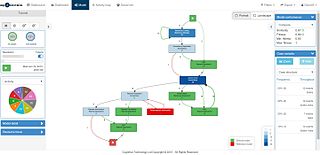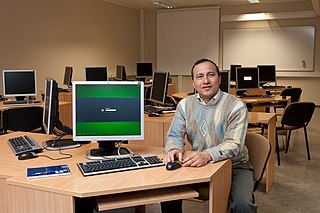
A workflow is a generic term for orchestrated and repeatable patterns of activity, enabled by the systematic organization of resources into processes that transform materials, provide services, or process information. It can be depicted as a sequence of operations, the work of a person or group, the work of an organization of staff, or one or more simple or complex mechanisms.

A Petri net, also known as a place/transition (PT) net, is one of several mathematical modeling languages for the description of distributed systems. It is a class of discrete event dynamic system. A Petri net is a directed bipartite graph that has two types of elements: places and transitions. Place elements are depicted as white circles and transition elements are depicted as rectangles. A place can contain any number of tokens, depicted as black circles. A transition is enabled if all places connected to it as inputs contain at least one token. Some sources state that Petri nets were invented in August 1939 by Carl Adam Petri—at the age of 13—for the purpose of describing chemical processes.

Carl Adam Petri was a German mathematician and computer scientist.
CPN-AMI is a computer-aided software engineering environment based on Petri Net specifications. It provides the ability to specify the behavior of a distributed system—and to evaluate properties such as invariants, absence of deadlocks, liveness, or temporal logic properties.
A workflow pattern is a specialized form of design pattern as defined in the area of software engineering or business process engineering. Workflow patterns refer specifically to recurrent problems and proven solutions related to the development of workflow applications in particular, and more broadly, process-oriented applications.

The XML Process Definition Language (XPDL) is a format standardized by the Workflow Management Coalition (WfMC) to interchange business process definitions between different workflow products, i.e. between different modeling tools and management suites. XPDL defines an XML schema for specifying the declarative part of workflow / business process.
YAWL is a workflow language based on workflow patterns. It is supported by a software system that includes an execution engine, a graphical editor and a worklist handler. It is available as open-source software under the LGPL license.
Process mining is a family of techniques relating the fields of data science and process management to support the analysis of operational processes based on event logs. The goal of process mining is to turn event data into insights and actions. Process mining is an integral part of data science, fueled by the availability of event data and the desire to improve processes. Process mining techniques use event data to show what people, machines, and organizations are really doing. Process mining provides novel insights that can be used to identify the execution paths taken by operational processes and address their performance and compliance problems.
Business process discovery (BPD) related to business process management and process mining is a set of techniques that manually or automatically construct a representation of an organisations' current business processes and their major process variations. These techniques use data recorded in the existing organisational methods of work, documentations, and technology systems that run business processes within an organisation. The type of data required for process discovery is called an event log. Any record of data that contains the case id, activity name, and timestamp. Such a record qualifies for an event log and can be used to discover the underlying process model. The event log can contain additional information related to the process, such as the resources executing the activity, the type or nature of the events, or any other relevant details. Process discovery aims to obtain a process model that describes the event log as closely as possible. The process model acts as a graphical representation of the process. The event logs used for discovery could contain noise, irregular information, and inconsistent/incorrect timestamps. Process discovery is challenging due to such noisy event logs and because the event log contains only a part of the actual process hidden behind the system. The discovery algorithms should solely depend on a small percentage of data provided by the event logs to develop the closest possible model to the actual behaviour.
A program structure tree (PST) is a hierarchical diagram that displays the nesting relationship of single-entry single-exit (SESE) fragments/regions, showing the organization of a computer program. Nodes in this tree represent SESE regions of the program, while edges represent nesting regions. The PST is defined for all control flow graphs.
Business process management (BPM) is the discipline in which people use various methods to discover, model, analyze, measure, improve, optimize, and automate business processes. Any combination of methods used to manage a company's business processes is BPM. Processes can be structured and repeatable or unstructured and variable. Though not required, enabling technologies are often used with BPM.

Business process conformance checking is a family of process mining techniques to compare a process model with an event log of the same process. It is used to check if the actual execution of a business process, as recorded in the event log, conforms to the model and vice versa.
The goal of content-oriented workflow models is to articulate workflow progression by the presence of content units . Most content-oriented workflow approaches provide a life-cycle model for content units, such that workflow progression can be qualified by conditions on the state of the units. Most approaches are research and work in progress and the content models and life-cycle models are more or less formalized.
Arthur Harry Maria ter Hofstede is a Dutch computer scientist, and professor of information systems at the Queensland University of Technology in Australia, and professor at the Eindhoven University of Technology, known for his work in workflow patterns, YAWL, and business process management.

Marlon Gerardo Dumas Menjivar is a Honduran computer scientist, and Professor of Software Engineering at the University of Tartu in Estonia, known for his contributions in the field of Business Process Management.
Mathias Weske is a German computer scientist, and Professor of Business Process Technology at the University of Potsdam, known for his contributions in the field of business process management and as a founder of the business Signavio.
Kees Max van Hee is a Dutch computer scientist, and Emeritus Professor at the Eindhoven University of Technology, known for his development of the process modelling tool ExSpecT, and his seminal work on workflow management.
Jan Verelst is a Belgian computer scientist, Professor and Dean of the Department of Management Information Systems at the University of Antwerp, and Professor at the Antwerp Management School, known for his work on Normalized Systems.
The International Conference on Business Process Management is an academic conference organized annually by the BPM community. The conference was first organized in 2003 Eindhoven, Netherlands. Since then the conference has been organized annually. The conference is the premium forum for researchers, practitioners and developers in the field of Business Process Management (BPM). The conference typically attracts over 300 participants from all over the world.
Process mining is a technique used to turn event data into insights and actions. Techniques used in process mining such as Process discovery and Conformance checking depend only one the order of activities executed in the operations. The event log not only contains the activity details, but also timestamps, resources and data accompanied with process execution. Careful analysis of the external details from the event log can reveal useful information that can be used for making predictions on decisions that might be taken in the future, efficiency and working dynamics of the team, and performance analysis.






